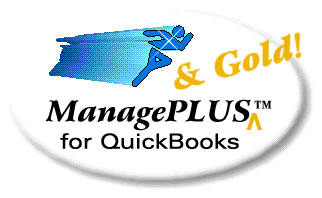The new release of ManagePLUS Goldâ„¢ for QuickBooks, from Flagship Technologies, Inc. (www.goflagship.com) lets users allocate expense from cost- and support-center classes and accounts to profit center classes, using a visual drag-and-drop approach.
Many businesses and nonprofit organizations use the classes feature of QuickBooks to track revenue and expense for the departments or activities of the organization—its cost centers, support centers, and profit centers, such as Office and Administration, Packing & Shipping, or Manufacturing. They set up classes to represent these, and apply those classes when entering transactions to identify income and expense with specific departments or activities.
This is all part of a cost accounting technique known as activity-based costing (ABC), the goal of which is to determine whether each income-producing area of the business—each profit center—is profitable. To get this done, the “overhead†expense accumulated for the organization’s cost centers must be allocated among profit centers on some reasonable basis.
Using QuickBooks by itself, allocation is anything but simple. It requires making journal entries or using “zero-dollar checksâ€, and there’s no way to automate the calculations involved. In fact, most users export transaction totals from QuickBooks to a spreadsheet, do the allocation calculations there, then manually enter the results as journal entries in QuickBooks. The entire process is difficult and offers plenty of opportunities for making errors.
ManagePLUS Gold overcomes all of these problems. With a couple mouse clicks, it retrieves transactions from QuickBooks and totals the amounts available for allocation from each class to other classes. Users then build allocation formulas visually by dragging a class onto the other classes to which it will be allocated. (The allocation formulas can be re-used in subsequent accounting periods, so the job is even faster and easier the next time.)
Because accuracy is just as important as ease of use, ManagePLUS Gold supports allocation based on “management quantities†the user has associated with individual classes, as well as on a percentage basis. Management quantities can be any physical or dollar amount related to the activity–things like labor hours, tons/gallons/bushels produced, miles driven, dollars of direct expense, etc. The result is spreadsheet-like allocation capability but without building spreadsheet formulas, exporting accounting data, or making journal entries.
Once allocations have been built, with a couple more mouse clicks the user can prepare a profit and loss report for any class, showing direct revenue and expense as well as the amounts that have been allocated to it.
But that’s not all. The new version 3.1 of ManagePLUS Gold adds the ability to send allocation transactions to QuickBooks, with a single click of the mouse. So now users can choose whether to get class profitability reports in ManagePLUS Gold or in QuickBooks, and have the option of doing anything with the allocation journal entries that they can do with other QuickBooks transactions—create customized reports, export them, include them in backups, etc.
Allocation capabilities are the “tip of the iceberg†with respect to ManagePLUS Gold’s features. Here’s a few of the other things it does:
– Lets users associate “extra†data with accounts and classes, and manages that data separately for each accounting period.
– Uses the “extra†data to automatically add management information and per-unit statistics to reports—things like average cost per unit of sales or per unit of production for each class.
– Provides advanced quantity handling and storage in QuickBooks transactions by supporting entry of two quantities per transaction, such as the weight and count of items bought or sold.
– Provides specialized reporting capabilities for the two-quantities feature, including automatic statistics like weight per each, count per weight, cost per weight (pound/ton/etc.), and cost per each.
– Supports advanced, automatic unit of measure labeling on reports.
ManagePLUS Gold sells for $149 per single-user license and is compatible with Microsoft Windows versions of the Pro, Premier, and Enterprise editions of QuickBooks, 2004 and later, including U.S., UK, and Canadian releases. A 30-day free trial is available to download from the product’s Web page:Â http://www.goflagshipcom/products/mphome.htm.
Via EPR Network
More Accounting press releases


